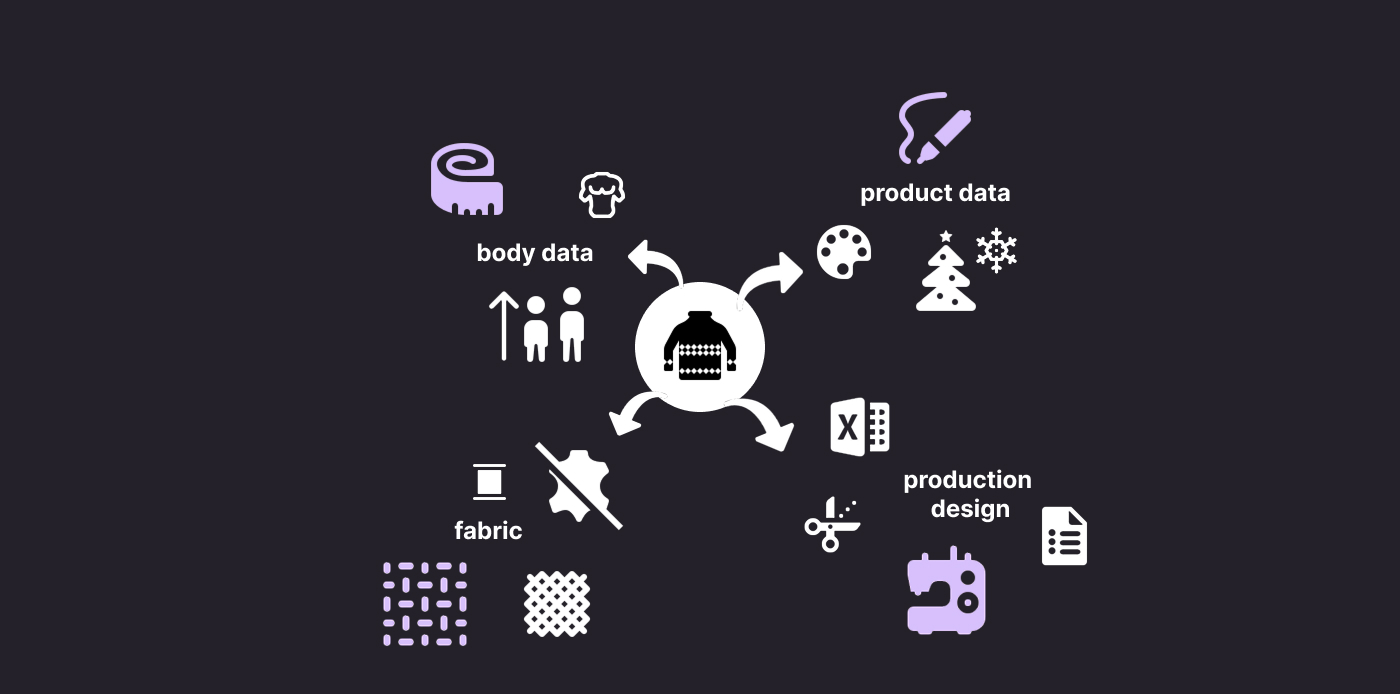Data has become a central asset for companies across industries. Organisations continuously collect and analyse information about customers, products, and operational processes to improve their business performance. In this article, we want to take a closer look at the fashion industry and its relationship with data (spoiler: it’s complicated). We will examine especially the strategic data management, its current status quo, and why it’s so necessary for fashion companies.
Introduction: What You Need to Know About the Fashion Industry
The fashion industry is a key player in the global economy, facing constant pressure from market shifts and economic uncertainty. It’s a sector that, while historically rooted in craftsmanship and tradition, has always evolved in response to technological and societal changes. As one of the oldest and most dynamic industries, fashion is currently empowered but also challenged by the emergence of big data and digital innovation. Additionally, it’s a highly competitive market environment, consisting of numerous firms offering similar products. Also typical for the whole industry is the widespread segmentation of products, which remain highly volatile due to the regular changes of seasons and trends.
Over recent decades, globalization and shifting consumer expectations have significantly transformed the structure and demands of the fashion market. Companies, therefore, must navigate highly complex supply chains, adapt rapidly to volatile trends, and meet growing expectations for personalisation and sustainability.
A fashion company typically has a complex structure that combines very different jobs, from highly creative to managerial and analytical roles. Because of this organisational complexity, it’s hard to analyse the fashion industry as one industry – still, in this article, we at least attempt to.
What Is Fashion Data?
Now that we’ve cleared up what makes the fashion industry special, it’s crucial to take a closer look at the characteristics and types of fashion data to get a better understanding of the complexity and possibilities of data management in the fashion industry.
In general, all data linked to a fashion product is commonly referred to as fashion data. Fashion-related data can be classified into:
- The fabric, which is characterized by its yarn, density, and so on;
- The product’s design, which combines principles and elements of design to shape a product, and is often influenced by emotions, themes, and occasions;
- The body data, which provides information about body measurements and body type, and is collected in 2D via measurements or in 3D using body scanners;
- The technical design of the production process, which helps producers understand how to make the product by incorporating pattern making, sewing, and other production-relevant skills.

Big data in fashion
Big data plays a crucial role in driving digital transformation across industries. In general, it refers to datasets that are too large or complex to be handled by traditional computing systems, often combining information from various sources. It’s large, often messy, and less precise than traditional small-scale datasets. One challenge of big data is that the datasets exceed the capacity of traditional software to process. In the fashion context, big data ranges from point-of-sales (POS) data to textile physical data and allows fashion brands to monitor popular products, analyse customer feedback, and understand shopping behaviour.
What Is Strategic Data Management?
Data management in general refers to the everyday handling and use of data within an organisation, while strategic data management can be defined as the structured and goal-oriented handling of data within an organisation. That which combines the technical and operational aspects of data management (such as data entry, registers, and quality) with overarching strategic leadership. This approach ensures that data is not only accessible and usable across teams but also embedded into decision-making processes and aligned with the organisation’s long-term objectives.
Based on this, we define strategic data management in this article as the combination of the operational foundation (data management) and the strategic perspective (data governance).
Why Is Strategic Data Management So Important?
The amount of data fashion companies generate and collect is increasing drastically, particularly due to the rise of fast fashion. This makes the efficient use of data a strategic necessity to enhance and strengthen production and operational processes. Digital-native competitors such as fast fashion giant Shein are redefining market standards through highly data-driven business models. Their ability to leverage consumer behaviour data, adapt supply chains and prices in real time, and predict fashion trends places traditional fashion brands under immense pressure.
Furthermore, the evolving regulatory landscape around data privacy adds additional layers of complexity. Fashion companies must not only implement data management practices but also build trust with consumers, because their data is a big part of the overall data sources a fashion company can profit from.
By the way: one super exciting way to make use of the customers’ data during online shopping is called behavioral data models, which is worth a read if you’re on the more technical side!
The role of data ethics
Strategic data management also should include a clear approach to data ethics. This is necessary to ensure a responsible use of data and algorithms. Companies can realise this by building trust through transparency, fairness, accountability, and compliance with regulations such as the General Data Protection Regulation (GDPR) in Europe, which protects individuals’ personal data. But ethical data practices not only protect individual rights: they also help to prevent bias and play a critical role in maintaining public trust in data-driven decisions.
The importance of data security
It’s especially important to include data security in the process of strategic data management, as customer data can include highly identifiable and sensitive information, which can be credit card numbers, demographic attributes, or records of private transactions. Therefore, companies should handle such data with particular care. Particularly when different datasets are stored together, the risk of the reidentification of a customer increases.
To summarize, you can say that:
- Deriving real value from data requires it to be actively managed.
- Defining clear strategic business goals makes it easier to later shape a matching data strategy, which in turn supports better data management and quality.
- Organisations require a comprehensive data strategy to align business goals with technical capabilities. The growing complexity of data makes a clear data strategy more crucial than ever.
- Especially in large organisations, poorly managed data from multiple sources can disrupt the organisation’s whole data flow. It is therefore very important to manage even basic data elements, like address formats or field definitions, early on to ensure consistency and avoid future complications.
- A foundational step in strategic data management is to treat data and information on par with financial or physical resources, since all of them have to be very carefully managed.
The Struggles of Handling Data in Companies in General
Some of the main and more general challenges in strategic data management lie in the shortage of skills, tools, and technologies. Companies struggle to collect data sources into one platform that supports a deeper understanding of the customers’ needs and the brand’s objectives. Without the necessary data skills and tools, companies often lack clarity and are not able to make informed decisions, ultimately risking their competitiveness. Every employee who creates, updates, or uses data impacts its quality and value, yet many are not aware of the consequences their actions may have. Also, the company’s managers are not mindful of the data they have access to. Sometimes, they create their own databases or buy external data without checking what data is already available in the company. That raises the question of whether the data is being used and managed effectively.
The Struggles of Handling Data in the Fashion Industry
Gallery & Conlon (2024) state in Fashion business and digital transformation: Technology and innovation across the fashion industry that “data management is a common problem in fashion companies” (p.21), because fashion companies are drowning in the increasing amount of data, overwhelmed by the various existing data sources. They struggle to manage it properly, including collecting, storing, and processing the data. Fashion companies not only have to navigate complex relationships with consumers, suppliers, competitors, and so on, but also have to face the challenge of managing highly interconnected and often uncertain data. Managers must consider vast amounts of data to optimise their operations, and effectively managing the data flows is essential for making informed business decisions.
What does a look at the current status quo reveal?
Many fashion companies, whether large or small, still rely heavily on Excel spreadsheets for data management due to their easy usage and practical, built-in functions. However, these tools carry a high risk of human error, require frequent updates, and are often inefficient when dealing with large datasets. As a result, organisations are increasingly considering integrated data platforms and smart workflows to enable more efficient, collaborative, optimised work. In practice, innovative and well-established data practices can have a tangible impact: they help detect overproduction early, reduce costs, increase sales, lower return rates, and enhance customer satisfaction through personalized experiences and stronger loyalty.
To achieve their business objectives, fashion companies need a clear understanding of their existing data, the data they still require, and how to structure it effectively, since poorly managed data holds very little strategic value. While other industries have already embraced data management as a core strategic function, the fashion retail sector is only beginning to explore the potential of big data to better understand customer behaviour and tailor its offerings accordingly.

Another common issue is the risk of data breaches, often caused by insecure data storage practices. Whether on physical servers or in the cloud, inadequate access controls or internal mishandling can expose sensitive company or customer data, highlighting the urgent need for better protection measures, clear access rules, and employee training to ensure secure data management.
These developments highlight how structured data usage can evolve from a simple technical necessity into a core strategic resource that can set the stage for more advanced, data-driven approaches such as trend forecasting, which we’re going to examine in a future article.
What Role Do Data Management Frameworks Play?
Data management is already a critical factor across various industries, either as an established process or an ongoing challenge. Therefore, it’s not surprising that a range of data management frameworks have been developed to guide organisations in handling data systematically. Such frameworks can be a useful and applicable reference for fashion companies seeking clarity when being overwhelmed by the strict data regulations or the data-related tasks and responsibilities they have to face. However, when they are rather complex, they might be less suitable for small, creatively led fashion businesses, which often face fewer structural data challenges.
Conclusion: What Fashion Company Leaders Should Keep in Mind
Many problems arise from the fact that employees don’t perceive data as a valuable resource but rather as something abstract and difficult to handle. Fashion companies should therefore invest in well-structured internal training or externally facilitated sessions to improve data literacy across the organisation, not just within dedicated data teams. Responsibilities related to data use and governance should be clearly assigned, especially for fashion companies based in the EU, in order to comply with increasingly strict data regulations. Also, well-managed data is essential for the effective implementation of advanced technologies like GenAI. These tools are highly data-driven and can only function meaningfully if the necessary foundations, such as data access, quality, and processes, are put in place.
As volume, complexity, and relevance of data continue to grow, the fashion industry must begin to embed data-driven practices more holistically into its operations. On one hand, this is essential to remain competitive in the market; on the other hand, to lay the groundwork for implementing innovative and effective applications of data or advanced technologies such as artificial intelligence (AI). This is just possible if foundational data management practices are already in place.
If you want to dive a bit deeper into the hot topics in data management, I recommend reading my colleague’s article about the data management trends in 2025.

